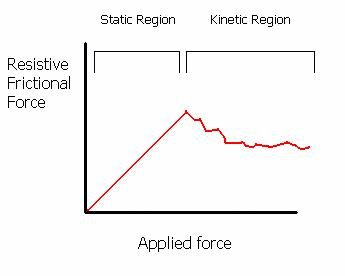Wherever bodies in contact move relative to each other there is friction. Even for bodies not in contact there may be friction – air resistance is a form of friction. Air resistance acts to dissipate kinetic energy as heat.
There are actually two sorts of friction. Static friction is the friction observed when bodies in contact are stationary relative to each other. There are electric forces in the surface atoms of each body which act to increase the force. When the bodies start to move relative to each other, these force disappear, but may re - apper intermittently throughout the period of motion. This is kinetic or dynamic friction in the diagram below.

|
Surfaces |
µ (static) |
µ (kinetic) |
|
Steel on steel |
0.74 |
0.57 |
|
Glass on glass |
0.94 |
0.4 |
|
Metal on Metal (lubricated) |
0.15 |
0.06 |
|
Ice on ice |
0.1 |
0.03 |
|
Teflon on Teflon |
0.04 |
0.04 |
|
Tire on concrete |
1 |
0.8 |
|
Tire on wet road |
0.6 |
0.4 |
|
Tire on snow |
0.3 |
0.2 |
Examples: There is friction in the bearings of engines and wheels. The friction can be reduced with the use of lubricating oil but it cannot be eliminated.
